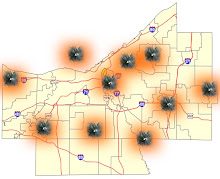It seems many are atwitter over the new proposed interchange in Avon, in Lorain County, just over the border from the "County of Choice," Cuyahoga County. More cars! Pollution! Big Boxes! More suburbia! Global Warming!
BOTC sees the usual greens + anti-sprawlers + bureaucratic do-gooders lining up to oppose such an infrastructural addition to the region. BOTC gets rather bored with the complaining and such and is always skeptical of the intentions and pretensions of such activist forces.
We would suggest that anyone involved with the planned interchange, either for or against, pick up Robert Breugmann's Sprawl: A Compact History (see website + list of reviews here). Breugmann's book situates American Sprawl within the greater history of urban decentralization and critical social commentary (Lewis Mumford, William Whyte, Herbert Gans, etc.). Breugmann also presents counterpoints to the many assertions made by anti-sprawlers and provides some of his own statistics.:
1. All of the urbanized area of the United State could fit into the state of Wisconsin
2. More acres of land are designated as parks, preserves, etc each year than are developed, and by a large margin.
And there are many more interesting facts, figures, and histories put forth.
The fact is that "sprawl" is the dominant + most dynamic urban form today. Yet do we try to decipher and analyze its structures, complexities, and potentials? Instead of merely criticizing from a far, can we not manage a way to co-opt sprawl's means and methods in order to create more palatable urbanisms?
BOTC recognizes that sprawl is by the most part "ugly." But that should not prevent us from discovering + deploying the tropes of decentralization for alternative solutions, that yes, can involve new interchanges in Lorain County.
UPDATE: Design Rag's Bradley is skeptical of my suggestions of co-opting tactics of sprawl.
First, please read this Lorain Morning Journal editorial first: The interchange is not using state or federal tax dollars. Note that non-retail development is planned around the area. Eastern Lorain County is growing and will need infrastructures to support its population, like healthcare institutions. Should residents in Lorain County be penalized because leadership elites in Cuyahoga County believe they know best? This is incumbentism and elitism at its worst.
Secondly, BOTC respects NU's progenitors for offering design solutions to "ugly" decentralization and growth. Instead of just throwing stones, NUs build. But BOTC suggests that NU is not co-opting sprawl in its purest form. We would suggest that Wright's Broadacre City schemes or Thomas Jefferson's plans for checkerboard cities in the Midwest should be reconsidered since each scheme excepts the notions of decentralization while still engaging the notions of civic responsibility, individual freedom, and an urbanism of intelligence. Why fight for "density" when historical evidence exhibits the continuing decentralization of American "urbansim"?
Subscribe to:
Post Comments (Atom)





2 comments:
I find the biggest reasons for the regional planning agency's study (and similar concern of many urban-minded individuals) on the new Avon interchange NOT in your characterizations of tree-hugging, dope-smoking, freedom-marching hippies against automobiles and global destruction, but a concern that this interchange is planned as a means for Avon's population and tax-base growth (which sad to say, will be more of the same "ugly" suburbanism that you acknowledge) in a region where population growth is stagnant.
I agree with you that better attention should be paid in exploring the design of suburban sprawl, but using public tax dollars to build a highway interchange on a greenfield so that developer Jacobs can build more of the same "ugly" suburbanism for a small percentage of the region's population (11,000 Avon residents in year 2000) seems counter-intuitive to the logic you suggest (i.e. reconsidering 'suburbanism').
Why don't we try to make the "ugly" suburbs that already exist work better? Or use available land that exists near a larger body of the population (e.g. empty car dealerships, forgotten shopping malls, underutilized parking lots) for the test sites of a 'better' suburbanism.
Hmmmm, actually, that's been done for about a decade or two now... its a planning and building practice called "New Urbanism" (from the Charter: "the reconfiguration of sprawling suburbs into communities of real neighborhoods and diverse districts...").
I am having a hard time understanding what new concept you suggest is NOT "New Urbanism" (from BOTC: "can we not manage a way to co-opt sprawl's means and methods in order to create more palatable urbanisms"). Maybe you are hinting that more Clevelanders should observe the under-appreciated tenets of New Urbanism.
I don't think that anyone is suggesting that investment in the center's of existing cities are absolute... as the Charter itself notes, a region should restore existing urban centers, reconfigure existing suburbs, and plan better communities to handle new population growth.
It sounds like "regional planning" means different things to different people. To folks in Cleveland Heights it means "Cleveland Heights" to folks in Westlake it means "Westlake" to folks in Cuyahoga County it means "Cuyahoga County." Folks in Northeast Ohio could move their rowboat faster if they all rowed in the same direction.
Post a Comment